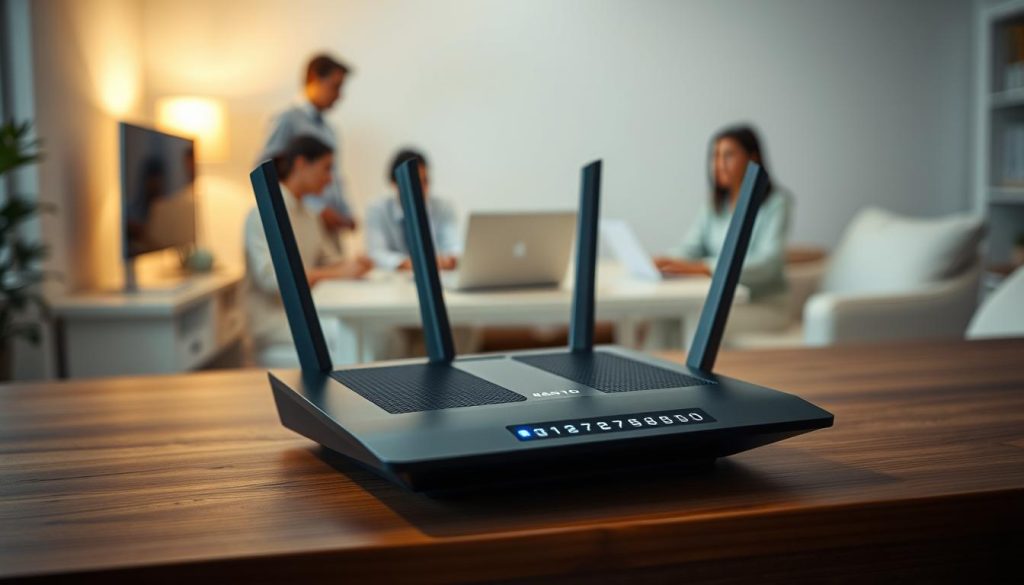When hosting gatherings or parties, providing internet access to your guests is a courtesy they often expect. However, giving them access to your main network can compromise the security of your personal devices. According to MidSouth Fiber Internet, a guest Wi-Fi network creates a separate access point within your router, allowing your guests to connect to another Wi-Fi network.
This setup is crucial for network security, especially when you have visitors. By creating a separate guest network, you can provide your visitors with internet access without putting your personal data at risk. In this section, we will discuss the importance of Wi-Fi best practices and outline the steps to secure your guest Wi-Fi network.
Understanding the Risks of Guest Wi-Fi
The risks associated with guest Wi-Fi are multifaceted, involving both the network itself and the devices connected to it. When you offer guest Wi-Fi, you’re providing convenience to your visitors, but you’re also potentially exposing your network to various cybersecurity threats.
Cybersecurity threats can arise from various sources, including hackers exploiting vulnerabilities in the network or devices connected to it. Guest Wi-Fi networks are particularly vulnerable because they often lack robust security measures, making them an attractive target for malicious actors.
- Unauthorized access to sensitive information
- Malware distribution through the network
- Man-in-the-middle attacks
- Denial of Service (DoS) attacks
To better understand these risks, let’s examine a comparison of common guest Wi-Fi security threats and their potential impacts.
| Threat | Description | Potential Impact |
|---|---|---|
| Man-in-the-Middle (MitM) Attack | Hackers intercept communication between two parties | Data theft, eavesdropping |
| Malware Distribution | Malicious software spread through the network | Device infection, data loss |
| Denial of Service (DoS) | Overwhelming the network with traffic | Network downtime, loss of productivity |
Understanding these risks is crucial for implementing effective cybersecurity tips and protecting your network. By acknowledging the potential threats, you can take proactive steps to secure your guest Wi-Fi network, ensuring a safer experience for both you and your guests.
Securing your guest Wi-Fi is not just about protecting your network; it’s also about safeguarding your guests’ sensitive information. By taking the necessary precautions, you can mitigate the risks associated with guest Wi-Fi and provide a secure and reliable connection for your visitors.
Creating a Separate Guest Network
Setting up a guest network is a simple yet effective way to protect your main network. By doing so, you isolate guest devices from your main network, preventing potential malware infections or unauthorized access to sensitive data.
Implementing Guest Network Isolation
To implement guest network isolation, you can use various router settings and features. Most modern routers support guest networking, allowing you to create a separate network for guests.
Key Benefits of Guest Network Isolation:
- Prevents malware spread from guest devices to your main network
- Protects sensitive data by limiting guest access
- Enhances overall network security
Here’s a comparison of different router settings for guest network isolation:
| Router Setting | Description | Security Benefit |
|---|---|---|
| Guest Network Isolation | Isolates guest devices from the main network | Prevents malware spread |
| MAC Address Filtering | Filters devices based on MAC addresses | Enhances device control |
| SSID Broadcast | Controls the visibility of the guest network | Reduces network visibility to unauthorized devices |

By implementing these settings, you can significantly enhance guest network safety and overall network protection. Regularly reviewing and updating your router settings will help maintain a secure network environment.
Strong Passwords and Authentication
Strong passwords and effective authentication are the first line of defense in securing your guest Wi-Fi network. Using complex passwords is crucial because they are harder for unauthorized users to guess or crack.
You should also implement multi-factor authentication to add an extra layer of security. This makes it more difficult for hackers to gain access to your network.
Implementing Multi-Factor Authentication
Multi-factor authentication requires users to provide two or more verification factors to access your guest Wi-Fi network. This significantly reduces the risk of unauthorized access, as a single password is no longer sufficient.
You can implement multi-factor authentication through various methods, including SMS codes, authenticator apps, or biometric verification.

By combining strong passwords with multi-factor authentication, you can significantly enhance the security of your guest Wi-Fi network. This approach not only protects your network from potential threats but also provides peace of mind for both you and your guests.
- Use complex passwords that include a mix of uppercase and lowercase letters, numbers, and special characters.
- Implement multi-factor authentication to add an extra layer of security.
- Regularly update and change passwords to maintain network security.
Enabling Network Encryption
Protecting your guest Wi-Fi with robust network encryption is a must for any network owner. Network encryption ensures that data transmitted between your wireless router and devices is secure, preventing eavesdropping and unauthorized access.

Encryption protocols like WPA3 play a critical role in safeguarding your network. By encrypting data, you ensure that even if someone intercepts the data, they won’t be able to read it without the decryption key.
Implementing WPA3 Encryption
WPA3 is the latest Wi-Fi security protocol designed to protect against various types of attacks and vulnerabilities. To implement WPA3 encryption, you need to access your router’s settings. Most modern routers support WPA3, but if your router is older, you might need to upgrade it to enable WPA3.
Steps to Enable WPA3 Encryption:
- Log in to your router’s administration panel.
- Navigate to the wireless settings section.
- Select WPA3 as the encryption protocol.
- Save your changes and restart your router.
By enabling WPA3 encryption, you significantly enhance your network security and provide secure Wi-Fi access to your guests. This step is crucial in maintaining the integrity of your network and protecting your guests’ sensitive information.
Regularly Updating Router Firmware
One of the most effective cybersecurity tips for network protection is regularly updating your router’s firmware. This process is crucial for maintaining the security and integrity of your network by patching known security vulnerabilities that could be exploited by cyber attackers.
Outdated firmware can leave your network exposed to various cyber threats. By keeping your router’s firmware up-to-date, you ensure that you have the latest security patches and features, thereby enhancing your network’s security posture.

To update your router’s firmware effectively, follow these best practices:
- Regularly check the manufacturer’s website for firmware updates.
- Follow the manufacturer’s instructions for updating the firmware to avoid any potential issues.
- Ensure your router is connected to a stable power source during the update to prevent interruptions.
- Backup your router’s current configuration before updating the firmware.
Updating your router’s firmware is not just about security; it’s also about maintaining the overall health and performance of your network. Here is a comparison of the benefits of keeping your firmware updated versus not updating it:
| Benefits | Updated Firmware | Outdated Firmware |
|---|---|---|
| Security | Latest security patches | Vulnerable to known threats |
| Performance | Improved stability and speed | Potential for bugs and slowdowns |
| Features | Access to new features | Limited functionality |
By regularly updating your router’s firmware and following best practices, you can significantly enhance your network’s security and performance. This simple step can make a substantial difference in protecting your network from cyber threats.
Limiting Guest Network Access
One of the most effective ways to protect your main network is by limiting guest network access. By doing so, you can prevent potential abuse and maintain the integrity of your network. This can be achieved through access controls and limiting device connectivity.
Access Controls are essential in managing who can use your guest network. You can configure your router to limit the number of devices that can connect to the guest network. This prevents overcrowding and reduces the risk of unauthorized access.
Limiting Device Connectivity
Limiting device connectivity is another crucial step. You can set a cap on the number of devices that can connect to your guest Wi-Fi network. This not only enhances security but also ensures that your network’s bandwidth is not overwhelmed.
To implement these measures, you can use guest Wi-Fi tips such as setting up a separate VLAN for your guest network and configuring your router to limit device connections. By securing your guest Wi-Fi, you can provide a safe and reliable internet experience for your guests while protecting your main network.
By following these guidelines, you can significantly improve the security of your guest network, ensuring a safe browsing experience for your guests while safeguarding your primary network.
Monitoring Guest Network Usage
Effective network security involves closely monitoring guest Wi-Fi usage to prevent unauthorized access. By doing so, you can identify and mitigate potential security threats, ensuring your network remains secure. Monitoring helps in understanding the traffic and usage patterns of your guest network, which is crucial for maintaining a secure and efficient network.
Why Monitor Guest Network Usage? Monitoring guest network usage is not just about security; it’s also about ensuring that your network resources are used appropriately. By keeping track of how your guest Wi-Fi is being used, you can prevent bandwidth hogging and ensure that your network remains stable and fast for all users.
Analyzing Network Logs
One of the key aspects of monitoring guest network usage is analyzing network logs. Network logs provide detailed information about the traffic on your network, including the devices connected, the data transferred, and the applications used. By analyzing these logs, you can identify suspicious activity, detect potential security threats, and take corrective actions to secure your network.
Tools for Analyzing Network Logs include specialized software that can parse through the logs, identify patterns, and alert you to any unusual activity. Some routers also come with built-in logging capabilities that can be accessed through their web interfaces. Utilizing these tools effectively can significantly enhance your network security.
To effectively monitor your guest network, it’s essential to regularly review network logs and adjust your security settings as needed. This proactive approach will help you stay ahead of potential security threats and maintain a secure and reliable network for your guests.
- Regularly review network logs to identify potential security threats.
- Use specialized software to analyze network logs and detect unusual patterns.
- Adjust your security settings based on the insights gained from log analysis.
By following these best practices for monitoring guest network usage, you can significantly enhance your network security and provide a safe and reliable Wi-Fi experience for your guests.
Educating Guests on Usage Policies
By educating your guests on network usage policies, you can significantly enhance guest network safety. This involves clear communication of what is expected from them when using your guest Wi-Fi.
Establishing Guest Network Etiquette
Establishing a clear guest network etiquette is essential. This includes guidelines on how to securely access the internet, the importance of keeping their devices updated, and the risks associated with public Wi-Fi networks.
To effectively educate your guests, consider displaying a welcome page or a pop-up with essential information when they log in to your guest Wi-Fi. This can include:
- Basic cybersecurity tips to protect their devices
- Information on the importance of using strong, unique passwords
- Guidelines on how to identify and avoid phishing scams
A well-informed guest is less likely to fall prey to common cyber threats. Here’s a simple table outlining key etiquette rules you might want to share:
| Etiquette Rule | Description | Benefit |
|---|---|---|
| Keep devices updated | Regularly update operating systems and software | Protects against known vulnerabilities |
| Use strong passwords | Avoid using easily guessable information | Prevents unauthorized access to devices and accounts |
| Avoid sensitive transactions | Refrain from accessing sensitive information on public Wi-Fi | Reduces risk of data theft |
By taking these steps, you not only enhance the security of your guest Wi-Fi network but also provide a safer browsing experience for your guests. Remember, a secure network is a shared responsibility between you and your guests.
Utilizing Guest Wi-Fi Management Tools
Secure your guest Wi-Fi network with management tools that offer monitoring, access control, and authentication features. These tools are crucial for maintaining the security and integrity of your network while providing guests with a seamless internet experience.
Guest Wi-Fi management tools offer a range of features that enhance network security and simplify management. Some of the key features include:
- Network Monitoring: Real-time monitoring of network activity to detect and respond to potential threats.
- Access Control: Control over who can access your network and what resources they can use.
- User Authentication: Secure authentication processes to ensure only authorized users can access the network.
Selecting the Right Tool
When selecting a guest Wi-Fi management tool, consider the specific needs of your network. Look for tools that offer customizable features, easy integration with your existing infrastructure, and comprehensive support. It’s also essential to choose tools that provide regular updates and have a user-friendly interface.
By utilizing the right guest Wi-Fi management tools, you can significantly enhance your network’s security and manageability, ensuring a safe and reliable internet experience for your guests.
Reviewing Security Practices Regularly
Regularly reviewing and updating your security practices is crucial to maintaining a secure guest Wi-Fi network. As new threats emerge, it’s essential to stay ahead by conducting regular security audits to identify vulnerabilities.
Updating Security Policies
Updating your security policies is vital to address new threats and vulnerabilities. You should regularly review your guest Wi-Fi network’s security settings and update your policies to ensure they remain effective. This includes re-evaluating password policies, network segmentation, and access controls.
By regularly reviewing your security practices and updating your policies, you can ensure your guest Wi-Fi network remains secure, protecting both your business and your guests from potential cyber threats. Effective Securing Guest Wi-Fi practices are key to maintaining network security and trust.

